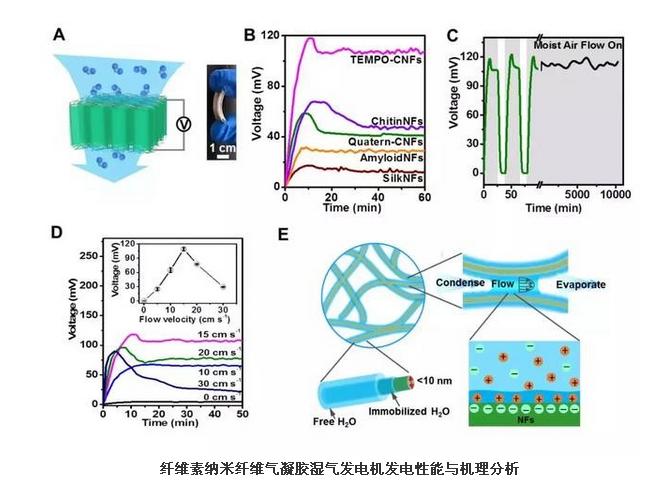With the energy crisis and environmental problems, the research and application of green and renewable energy devices have received worldwide attention. Among them, solar energy, thermal energy, mechanical energy, wind energy, bioelectrochemical energy, etc. have been used to generate electricity, and have broad application prospects in self-powered systems and wearable fields. However, the above energy forms still have more limitations in application, for example, solar power plants require continuous illumination; friction or pressure power generation requires continuous relative motion, and requires high mechanical properties of materials and devices. Recently, moisture, as a resource widely present in nature and biological processes, is being used to generate electricity, expanding the resources available in the natural world for power generation. However, current moisture power generation is mainly achieved by the interaction of carbon nanomaterials with water (water vapor). For example, after Qu Liang et al. treated the graphene oxide film electrochemically, the oxygen-containing functional groups on the upper and lower surfaces of the film exhibited a controlled gradient distribution state. The gradient distribution structure of the oxygen-containing functional group causes the humidity of the upper and lower surfaces to be in a gradient arrangement when the film is exposed to moisture, which causes positive and negative charge separation and directional movement, thereby generating a potential difference of 0.2 V on the upper and lower surfaces. . However, the macro-preparation of carbon nanomaterials is difficult and costly, and complex device structures also affect large-scale applications. Low-cost, high-performance moisture power generation materials and device development is still the focus and difficulty of research in this field. On the other hand, in nature, many organisms and human physiological processes are accompanied by bioelectrical phenomena based on body fluids/tissue fluids. For example, sap transports from the bottom up in the trunk will produce a flow potential; the cell membrane has a transmembrane potential due to differences in internal and external ions and concentrations. Despite the huge biomass production, low cost and green renewables, the use of bio-based materials in combination with water/moisture to produce power plants still poses significant challenges. Recently, Li Zhaoxu Research Group of Qingdao Institute of Bioenergy and Process, Chinese Academy of Sciences found that aerogels of biomass nanofibers (cellulose nanofibers, silk nanofibers, chitin nanofibers, Amyloid nanofibers, etc.) have good air absorption properties. This is mainly because on the one hand, the surface of the bio-based nanofiber material has abundant hydrophilic groups (such as hydroxyl group, carboxyl group, quaternary ammonium group, amino group, etc.); on the other hand, based on the Kelvin capillary condensation principle, the small size effect of the nanofiber (the diameter is generally The <10 nm) and aerogel's hierarchical pore structure is more conducive to steam condensation (Figure 1). Therefore, when a gas stream having a certain humidity (relative humidity > 50%) passes through the aerogel, the vapor is trapped by the aerogel in the form of bound water and free water, and the groups such as carboxyl groups on the surface of the fiber are dissociated and then on the surface of the fiber. Forming an electric double layer, the aerogel has a humidity difference before and after the aerogel, the front end moisture condensation and the back end water evaporation reach equilibrium, and the solution in the inner surface of the aerogel and the pore flow forms a flow potential, thereby preparing a bio-based nanofiber aerogel Moisture generator. Further research indicates that the generator is basically in accordance with the Smoluchovsky flow potential formula (Figure 2). Kids Indoor Boots,Kids Waterproof Indoor Boots,Indoor Shoes For Kids,Cartoon Children Home Boots Huaian sunrise shoes Co.,Ltd , https://www.hssindoorslippers.com
 The bio-based nanofiber aerogel power generation device prepared in this study has many advantages such as low cost, high biocompatibility, and biodegradability, and the bio-nano fiber can be prepared by using agricultural and forestry and fishery waste as raw materials. The device is suitable for powering small wearable electronic devices, and due to the presence of moisture in human activities (breathing, sweating, etc.), its power generation signal may be closely related to the intense activity, and it is expected to be used for self-powered health monitoring devices. The study was published in the recent issue of Advanced Functional Materials.
The bio-based nanofiber aerogel power generation device prepared in this study has many advantages such as low cost, high biocompatibility, and biodegradability, and the bio-nano fiber can be prepared by using agricultural and forestry and fishery waste as raw materials. The device is suitable for powering small wearable electronic devices, and due to the presence of moisture in human activities (breathing, sweating, etc.), its power generation signal may be closely related to the intense activity, and it is expected to be used for self-powered health monitoring devices. The study was published in the recent issue of Advanced Functional Materials.
September 13, 2024